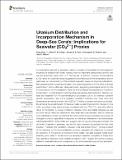Files in this item
Uranium distribution and incorporation mechanism in deep-sea corals : implications for seawater [CO32–] proxies
Item metadata
| dc.contributor.author | Chen, Sang | |
| dc.contributor.author | Littley, Eloise F. M. | |
| dc.contributor.author | Rae, James W. B. | |
| dc.contributor.author | Charles, Christopher D. | |
| dc.contributor.author | Adkins, Jess F. | |
| dc.date.accessioned | 2021-04-08T10:30:26Z | |
| dc.date.available | 2021-04-08T10:30:26Z | |
| dc.date.issued | 2021-03-23 | |
| dc.identifier | 273686787 | |
| dc.identifier | 584811e0-063f-46eb-ab33-8bd5af43bca9 | |
| dc.identifier | 000637004100001 | |
| dc.identifier | 85103756797 | |
| dc.identifier.citation | Chen , S , Littley , E F M , Rae , J W B , Charles , C D & Adkins , J F 2021 , ' Uranium distribution and incorporation mechanism in deep-sea corals : implications for seawater [CO 3 2– ] proxies ' , Frontiers in Earth Science , vol. 9 , 641327 . https://doi.org/10.3389/feart.2021.641327 | en |
| dc.identifier.issn | 2296-6463 | |
| dc.identifier.other | Jisc: 65fbb88a54ea44f38c4c62cde6237ced | |
| dc.identifier.other | ORCID: /0000-0003-3904-2526/work/92020065 | |
| dc.identifier.other | ORCID: /0000-0003-1442-7585/work/92020165 | |
| dc.identifier.uri | https://hdl.handle.net/10023/22983 | |
| dc.description | This research received funding from NSF grant OCE-1737404 awarded to JA and China Scholarship Council Ph.D. Scholarship 201508020007 awarded to SC. JR was supported by ERC Starting Grant 805246 OldCO2NewArchives. | en |
| dc.description.abstract | A conservative element in seawater, uranium is readily incorporated into the aragonitic skeletons of scleractinian corals, making them an important paleoclimate archive that can be absolutely dated with U-Th techniques. In addition, uranium concentrations (U/Ca ratios) in corals have been suggested to be influenced by the temperature and/or carbonate ion concentration of the ambient seawater based on empirical calibrations. Microsampling techniques have revealed strong heterogeneities in U/Ca within individual specimens in both surface and deep-sea corals, suggesting a biological control on the U incorporation into the skeletons. Here we further explore the mechanism of uranium incorporation in coral skeletons with the deep-sea species Desmophyllum dianthus, an ideal test organism for the biomineralization processes due to its relatively constant growth environment. We find a negative correlation between bulk coral U/Ca and temperature as well as ambient pH and [CO32–] that is consistent with previous studies. By sampling the growth bands of individual corals, we also find a twofold change in U/Ca within individual corals that is strongly correlated with the δ18O, δ13C, and other Me/Ca ratios of the bands. A similar correlation between U/Ca and stable isotopes as well as other Me/Ca ratios are observed in bulk deep-sea coral samples. With a numerical coral calcification model, we interpret the U/Ca-stable isotope correlation as a result of changes in uranium speciation in response to internal pH elevations in the extracellular calcifying fluid (ECF) of the corals, and suggest that the Ca2UO2(CO3)3(aq) complex, the dominant U species in seawater, may be the major species incorporated into the coral skeleton. Therefore, the correlation between U/Ca and ambient [CO32–] is likely a result of the response of the biomineralization process, especially the magnitude of internal pH elevation, to the growth environment of the corals. Our data suggest overall lower alkalinity pump rates in corals from low saturation seawater compared to those from high saturation seawater, and possible increases in Ca2+ supply from active pumping relative to seawater transport in response to the environmental stress of low saturation. | |
| dc.format.extent | 14 | |
| dc.format.extent | 4367662 | |
| dc.language.iso | eng | |
| dc.relation.ispartof | Frontiers in Earth Science | en |
| dc.subject | Deep-sea corals | en |
| dc.subject | Uranium | en |
| dc.subject | Carbonate ion | en |
| dc.subject | Biomineralization | en |
| dc.subject | Stable isotopes | en |
| dc.subject | GE Environmental Sciences | en |
| dc.subject | DAS | en |
| dc.subject.lcc | GE | en |
| dc.title | Uranium distribution and incorporation mechanism in deep-sea corals : implications for seawater [CO32–] proxies | en |
| dc.type | Journal article | en |
| dc.contributor.sponsor | NERC | en |
| dc.contributor.sponsor | European Research Council | en |
| dc.contributor.institution | University of St Andrews. School of Earth & Environmental Sciences | en |
| dc.contributor.institution | University of St Andrews. St Andrews Isotope Geochemistry | en |
| dc.identifier.doi | 10.3389/feart.2021.641327 | |
| dc.description.status | Peer reviewed | en |
| dc.identifier.grantnumber | NE/N003861/1 | en |
| dc.identifier.grantnumber | 805246 | en |
This item appears in the following Collection(s)
Items in the St Andrews Research Repository are protected by copyright, with all rights reserved, unless otherwise indicated.

